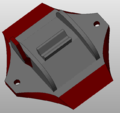Rain gauge
This section shows the journey for making our 3D print rain gauge!
Design journey
We didn't start from scratch - we work on Suromark's version (referred as original design in the following) and we did some changes to that:
First, we noticed that the tipping bucket can get stuck to the pivot if operated overnight, so we changed the flipper with 0.6 mm clearance. Secondly, we noticed that not all of the water in the bucket can escape when tipping. We compared with the standard tipping bucket rain gauge design, and we added a sharp edge and made some "swale" in the bucket to help divert water when tipping:
Thirdly, we found water can be soaked into the tipping bucket during long-time operation so we changed the 3D print from 30% infill to 100% infill;
In the end, we found that the tipping volume can change from time to time. We found during the overnight operation, a small amount of water from splashing or dripping can stay on the rain gauge base, which probably increases the friction between the base and bucket, therefore influencing the tipping volume. In that case, we changed the base design - to make water can easily escape so the tipping volume is consistent.
Application
We have used these rain gauges in Xixi Shi's lab-wetlands to monitor the outflow rate. There are 6 wetlands in total, and we have equipped each wetland outlet with a rain gauge to monitor the outflow rate.
This is the calibration for each rain gauge tipping bucket:
| Rain gauge tipping volume(ml) | Feb 16 3pm | Feb 17 11am | overnight difference (%) |
|---|---|---|---|
| R1 | 2.8 | 2.8 | 2 |
| R2 | 2.9 | 2.9 | 2 |
| R3 | 2.8 | 3.1 | 9 |
| R4 | 2.9 | 3.1 | 7 |
| R5 | 3 | 3 | -1 |
| R6 | 3 | 2.9 | 2 |
3D print files
Thanks Stephen for designing and editing the files!
Nano Board code
Thanks Luke(Baiqian) Shi for the coding :)




